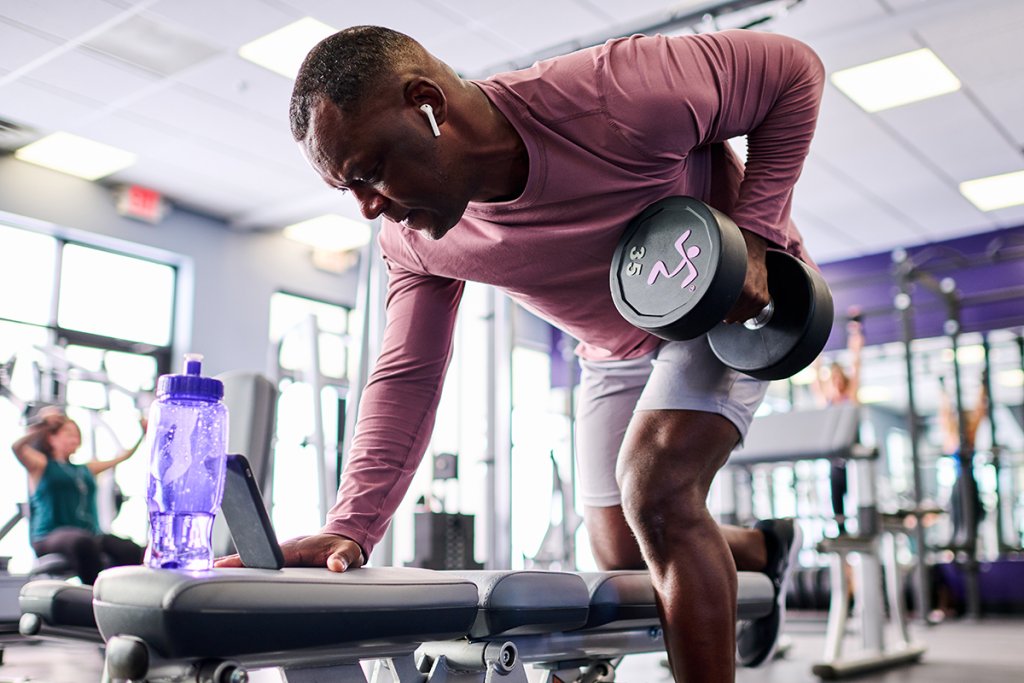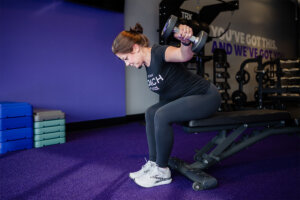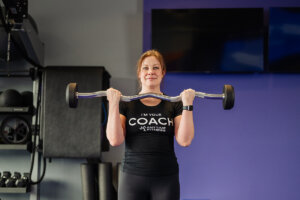Whether you’re a seasoned gym veteran or just starting your strength-training journey, pull day workouts are an essential part of any well-rounded workout routine, which can also include push days, leg days, cardio, and so on. While focusing on pushing movements (like bench press, chest flies, and overhead press) is important, don’t sleep on targeting your biceps, forearms, and back muscles with pulling exercises. It not only tones arms and shoulders, but boosting those back muscles helps strengthen your entire body.
However, with so many exercises to choose from, designing an effective pull day routine can feel overwhelming. But as always, we’ve got you! Let’s break down the importance of pulling exercises and the muscles they work before we dig into our coach-created pull day routine.
What is a pull day workout?
“A pull day workout is focused on the exercises that use a ‘pull’ range of motion,” says AF Coach Heather Anderson. “When performing pull exercises with free weights, the weights will move closer to the body when the muscles contract, as opposed to the weights moving away from the body — as is the case with pushing and pressing exercises.”
Generally, pull exercises focus on the upper-body pulling muscles, which are the back and the biceps, but they can also include other muscles in the shoulders, neck, and forearms.
Why pull day workouts are important
A balanced workout program will target all major muscle groups, including the pull muscles. The muscles that perform pulling motions are particularly important for ensuring proper posture, because they counterbalance the push muscles (the chest and anterior deltoid portion of the shoulder). Strengthening the back muscles can also help you avoid lower back pain.
While the muscle gains are great, pull exercises can also give you a lot of other long-term benefits. Pull day workouts can also:
- Protect your bone health
- Make daily activities easier
- Increase your level of endorphins
- Build muscle mass and boost metabolism to help your body burn more calories
- Enhance your thinking skills
- Manage chronic conditions
Pull day vs. push day: Which is harder?
When it comes to pull day and push day workout routines, one isn’t technically “harder” than the other. Both pull and push day workouts help you build strength, but the exercises target different muscle groups.
Pull day muscles worked
When doing any type of pulling exercise, you’re working a combination of the following:
- Biceps
- Back muscles
- Forearms (wrist flexors, wrist extensors, and muscles)
- Rear delts
- Trapezius
Push day muscles worked
When doing any type of pushing exercise, you’re working a combination of the following:
- Shoulder muscles
- Chest/pectoral muscles
- Triceps
If your goal is to build more upper-body strength, a push-pull workout routine is the way to go. Splitting workouts into push days and pull days allows you to work every muscle group multiple times per week, while still allowing muscles time to recover from those exercises. As a result, you’ll build strength in less time.
Here’s what a typical weekly workout split could look like:
- Pull day
- Push day
- Legs
- Pull day
- Push day
- Legs
- Rest
You’ll find our Pull Day Workout routine below, and here’s a Push Day Workout to incorporate into your weekly split.
Who should do pull day workouts
The short answer: anyone! Pull exercises are important across the board. As mentioned above, the back muscles serve as a counterbalance to the push muscles (i.e., chest and the anterior deltoid). Chest and anterior muscles are frequently overused because we as humans are forward-facing and most everyday activities — think driving, texting, cooking, etc. — are done in the front of our body. This can mean those front-of-body muscles are often overused, tightened, and shortened.
You’ve heard that every action has a reaction, and that’s true with muscle groups. A tight, shortened muscle will lead to an antagonist (opposing) muscle — like in the back — being lengthened, and therefore weakened.
Tell-tale signs of weakened back muscles are shoulders that are rounded forward. Incorporating pull day workouts will help decrease imbalances between the push and pull muscles, and over time, can help correct posture.
How many exercises should I do on a pull day?
A typical pull day workout varies based on the person, but we recommend somewhere between 6 and 8 different exercises. The set-up of these pull day routine exercises means you’re able to do them relatively quickly, taking 1–2 minutes per exercise.
How to stretch for a pull day workout
A proper warm-up for a pull day workout will include special attention to mobility drills for the back and shoulders, as well as activation exercises to further prime the muscles in the back.
Pull day body mobility stretches:
Thoracic Rotations
- Start on your hands and knees, with your hands directly underneath your shoulders and your knees beneath your hips.
- Place one hand behind the head.
- Rotate down and across the body, touching your elbow to the opposite wrist.
- Rotate back across, opening your chest and shoulder on the other side.
- Do 8–12 reps on each side.
Open-Book Windmills
- Lay on your left side with your left leg extended and your right leg in a 90-degree bend over the top of the roller.
- Stack your shoulders on top of each other.
- Close your arms and hands together, palm to palm.
- Reach your top arm up overhead and rotate your palm to the ceiling.
- Complete a full rotation back to the starting position.
- Do 8–12 reps on each side.
Pull day muscle activation stretches:
Banded Pull-Aparts
- Stand upright holding the ends of a band in each hand with your arms extended out in front.
- Pull your hands apart at various angles, lengthening the ends of the band while maintaining a neutral, upright spine.
- Repeat for 60–90 seconds.
Banded Straight-Arm Lat Pulldown
- Anchor the band at chest height and grab the handles of the band.
- Slightly flex the hips and knees with your arms extended straight overhead.
- Initiate the movement by pulling your shoulders back and down, then pull your arms down and back to your sides.
- Let the band pull the arms back to the starting position. Keep your arms and back straight throughout.
- Repeat for 60–90 seconds.
Pull Day Workout Routine
There are many ways to structure your pull day workout, including horizontal and vertical training, German volume training, and every variation in between. For our workout, we’re going to break the 6 recommended exercises into two circuits. Each circuit has two exercises that target back muscles, followed by a bicep curl variation. This structure gives the back muscles time to rest as you focus on the biceps:
- Circuit A: Pull-Ups, Bent-Over Rows, and Cable Bicep Curls
- Circuit B: Inverted Rows, Bent-Over Flys, and Concentration Curls
You’ll perform all the exercises in Circuit A before moving on to Circuit B.
Structure of the pull day workout based on your fitness level
To decide how many reps and sets to perform, follow this guide:
- Beginner level: Begin with 8–12 reps, performed for 3–4 sets with moderate weights. Continue training at this volume until you feel confident in your form and are ready to move to heavier weights.
- Intermediate: To focus on muscle growth and gains in size (also known as hypertrophy), increase to 4–5 sets of 6–10 reps using moderate to moderate-heavy weights.
- Experienced: To train for maximal strength, incorporate training with heavy weights that only allow for 1–3 reps per set.
Resting between sets based on your fitness level
During your pull day workout, rest only as much as needed between sets.
- Beginner level: Start with 30 seconds between sets and adjust from there.
- Intermediate: As you gain strength and begin training for size, your rest period will increase because you are exerting more to lift heavier loads. Increase your rest period to up to 60 seconds between sets.
- Experienced: When training for max strength, rest as long as needed between sets, as you’ll be training at or near your maximum capacity for performance.
Pull Day Circuit A
1. Pull-Ups
Muscles targeted: Lats, traps, rhomboids, shoulder muscles, biceps
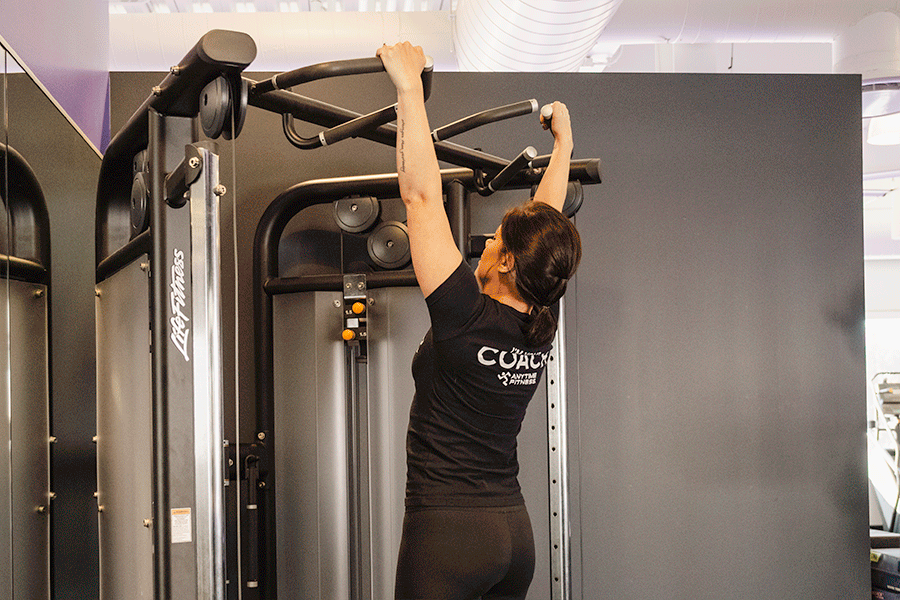
How to:
- Hang from the bar with your arms fully extended and your body in a straight line from head to heels.
- Begin the pull-up by squeezing your shoulder blades together and pulling your chest toward the bar. Focus on using your back and biceps to lift your body, rather than just your arms.
- As you pull up, keep your elbows close to your body and aim to bring your chin above the bar. When your chin is above the bar, pause for a moment to ensure you’ve completed the full range of motion
- Slowly lower your body back down to the starting position with your arms fully extended.
- Maintain control throughout the descent, and don’t let your body swing or jerk.
- Reps: Based on your fitness level (above)
Modification: If you’re not able to do a full pull-up yet, try using an assisted pull-up machine or do a suspended pull-up. Sit underneath the suspension straps, hanging on to the handles with your arms fully extended. Lift your chest and engage your back muscles as you pull up toward the anchor point above you. Your feet can assist you by lifting some of your body weight if needed. Lower back down into the start position.
RELATED: Get to Your First Pull-Up
2. Single-Arm Bent-Over Row
Muscles targeted: Lats, middle and lower traps, rhomboids
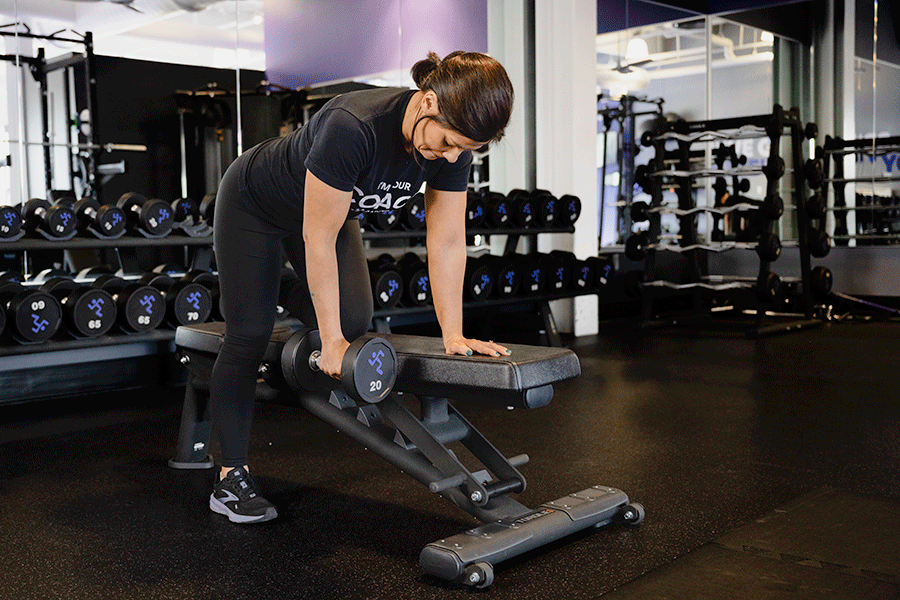
How to:
- Holding a dumbbell in one hand with your arm straight, place the opposite knee and hand on a bench. Keep your back flat.
- Lift the dumbbell up to the side of your chest, bending at the elbow.
- Lower the dumbbell back to a straight-arm position, keeping your back flat throughout.
- Complete all reps on one side before switching to the other side.
Modification: You can also use a barbell for this exercise. Bend forward at your waist with your knees slightly bent and your back flat. Hold a barbell with your arms straight. Lift the barbell up to your chest, bending at the elbows. Lower the barbell back to a straight-arm position, keeping your back flat throughout.
3. Cable Biceps Curl
Muscles targeted: Biceps
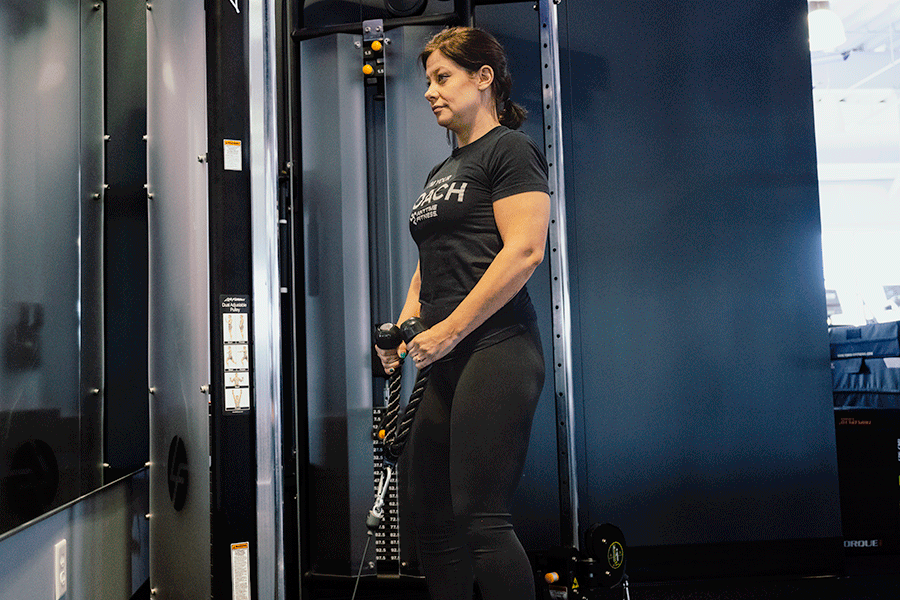
How to:
- Stand upright and hold the bar underhanded with your arms straight and your elbows at your sides.
- Raise the bar up to your shoulders, bending at your elbows, keep them by your sides.
- Lower the bar back down slowly.
- Do not sway back and forth as you lift and lower the bar.
- Reps: Based on your fitness level (above)
Modification: For this exercise, you can use a barbell for this exercise in place of the cable machine.
Pull Day Circuit B
Complete all sets of Circuit A before moving to Circuit B.
4. Single-Arm Pulldown
Muscles targeted: Lats, teres major, traps, rhomboids
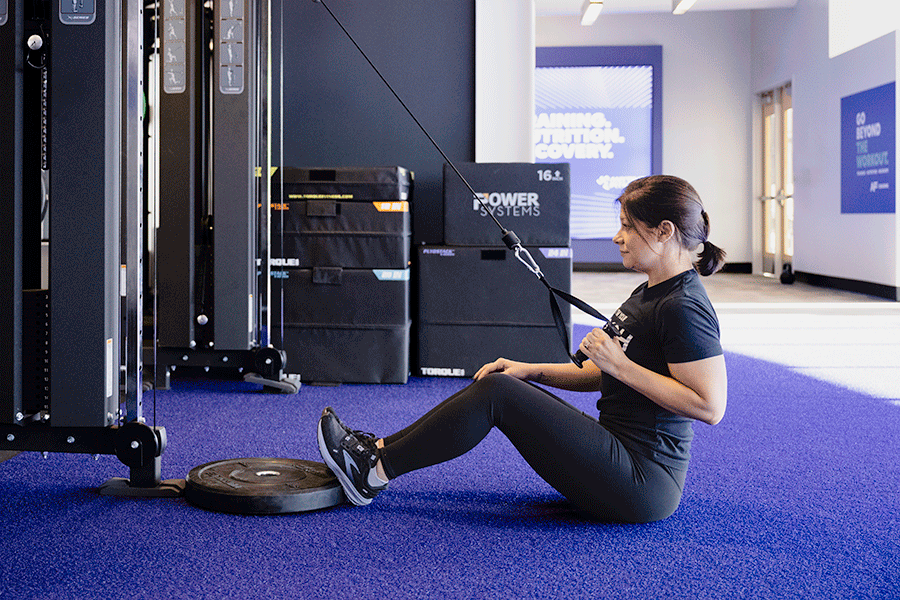
How to:
- Sit on a bench bent or the floor and grab the handle.
- Pull the handle down, squeezing your elbow to your side as you flex the elbow.
- Pause at the bottom of the motion, and then slowly return the handle to the starting position.
- Keep your upper body stable throughout.
- Reps: Based on your fitness level (above)
5. Inverted Row
Muscles targeted: Lats, traps, posterior delt, biceps
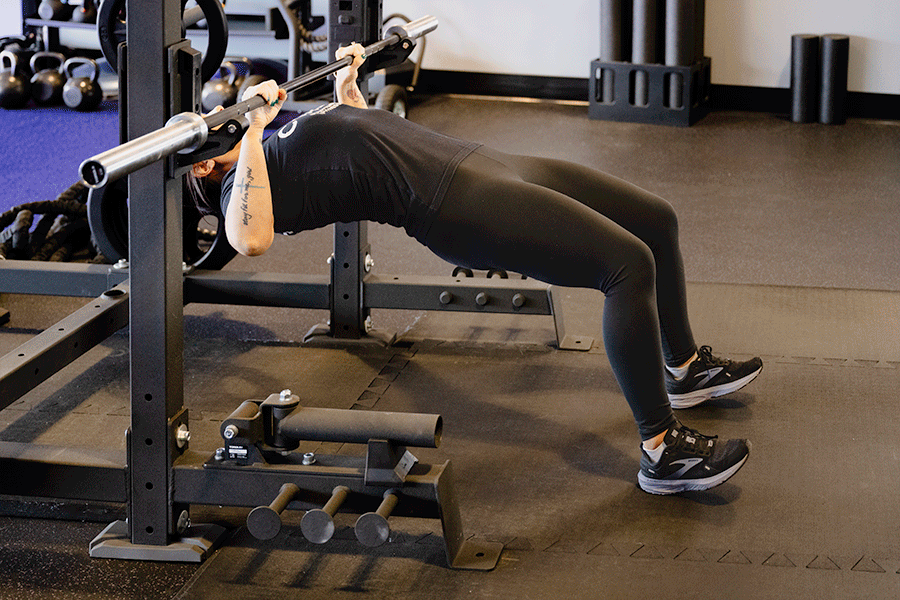
How to:
- Hold onto a barbell with a wide grip, your arms and body straight and your heels on the floor.
- Pull your chest up to the bar, bending at the elbows, keeping your body straight.
- Lower your body back to a straight arm position.
- Reps: Based on your fitness level (above)
6. Concentration Curl
Muscles targeted: Biceps and forearms
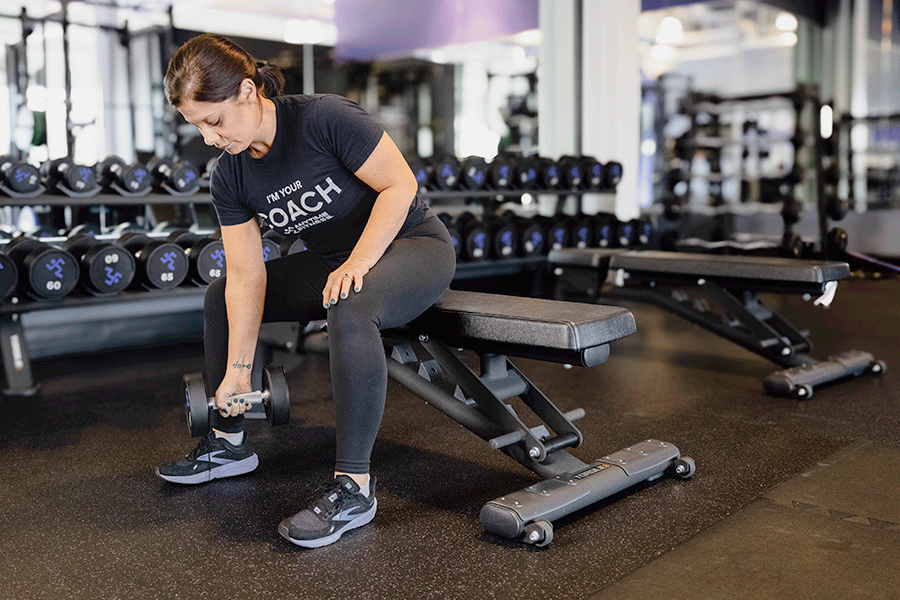
How to:
- Sit on a bench holding a dumbbell with your elbow resting on your inner thigh and your arm straight.
- Raise the dumbbell up to your shoulder, bending at the elbow.
- Keep your elbow on your inner thigh throughout.
- Complete all reps on one side before switching to the other side.
A final word on pull day exercises
Overall, pull day workouts are an essential part of any well-rounded workout routine. Aside from reducing body fat, increasing lean muscle mass, and burning calories more efficiently, strength training is key to overall endurance and improving everyday life. This coach-created pull day routine is a great place to start when it comes to maximizing your time in the gym and getting the most out of your workouts.
That said, personalized routines will get you the most bang for your buck, making good on every ounce of energy you put into your workout. To take your workouts a step further, talk to an AF Coach one-on-one. Our coaches build workouts unique to your goals that are designed to make you stronger from the inside out.
Want more strength workouts like this?
Try these related pull day exercises and upper-body workouts:
The Anytime Fitness App lets you access personalized coaching around the clock from our personal trainers. Download it now.
